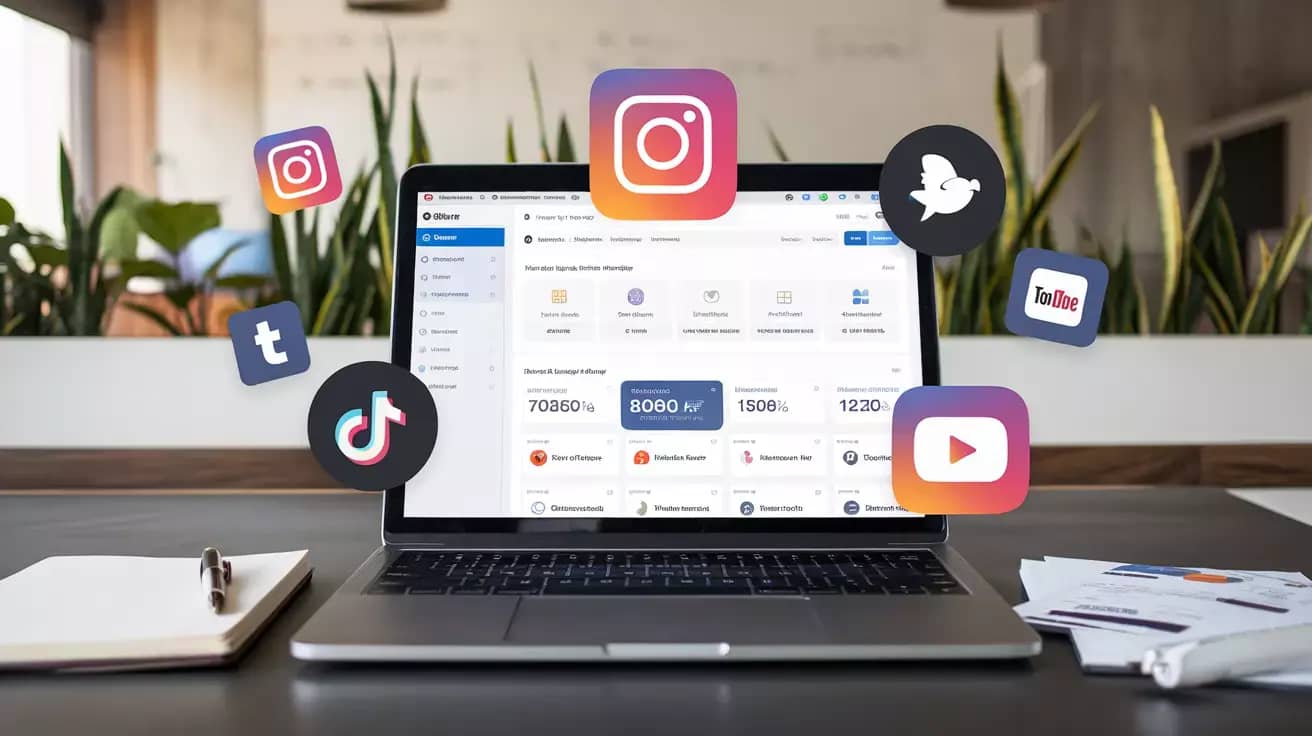Did you know that 80% of marketers find influencer marketing effective ? Yet, many businesses struggle to get started because they don’t know where to begin.
Let me tell ya, when I first dipped my toes into influencer marketing , I thought it was just another buzzword—like those neon fanny packs from the ‘90s. But boy, was I wrong! It’s actually one of the most powerful ways to connect with your target audience authentically. Whether you’re running a small business or managing a growing brand, this guide will walk you through everything you need to know to launch your first influencer marketing campaign.
In this article, we’ll cover the basics, set clear goals, find the right influencers, create engaging content, and measure success. By the end, you’ll feel confident enough to dive in and start seeing results. So grab a coffee ☕, sit back, and let’s get started!

1. Understanding Influencer Marketing Basics
You’ve probably heard about influencer marketing before, but what exactly is it? Well, let me break it down for ya. Influencer marketing involves partnering with individuals who have a dedicated following on social media platforms. These influencers create content that promotes your product or service, helping you tap into their engaged audience.
Why does it work so well? People trust recommendations from real humans more than traditional ads. Think about it—if your favorite fitness guru raves about a protein shake, wouldn’t you be more likely to try it? That’s the magic of authenticity .
Some key benefits include:
- Boosting brand awareness (cha-ching! ).
- Driving higher engagement rates compared to standard ads.
- Increasing ROI since micro-influencers often charge less but deliver big results.
For example, Glossier—a skincare brand—grew massively by collaborating with beauty bloggers. They didn’t just sell products; they built a community around their brand.
Here’s why this works:
✨ Trust : Influencers already have loyal followers who value their opinions.
✨ Reach : You can access audiences you might not reach otherwise.
✨ Authenticity : Influencers bring personality and relatability to your message.
But here’s the kicker: Not all influencers are created equal. Some focus on niche topics like zero-waste living , while others cater to broader audiences like wellness enthusiasts . The trick is finding someone whose values align with your brand.
Pro Tip: Always vet influencers carefully. Look for red flags like fake followers or low engagement rates. Tools like BuzzSumo or HypeAuditor can help you analyze their performance.

2. Setting Clear Goals for Your Campaign
Alright, let’s get down to brass tacks. Before jumping into anything, you gotta set some clear goals. Trust me, I’ve seen too many campaigns flop because folks skipped this step.
Here’s how to do it right:
- Define Your Objectives : Are you looking to boost brand awareness , generate leads, or increase sales? Pick one primary goal.
- Example: “Increase website traffic by 20% in 3 months.”
- Align with Your Overall Strategy : Make sure your influencer campaign fits into your broader marketing plan. Don’t go rogue here!
- Use SMART Goals : Specific, Measurable, Achievable, Relevant, Time-bound.
For instance, if you’re promoting a new line of hemp-based supplements , your goal could be:
🎯 “Partner with 5 micro-influencers to promote our hemp oil capsules and achieve a 15% increase in online orders within 2 months.”
Pro Tip: Start small. If you’re new to this game, aim for modest wins before scaling up.
Here’s why setting goals matters:
✅ Focus : Keeps your campaign aligned with business objectives.
✅ Measurement : Helps you track progress and adjust as needed.
✅ Motivation : Gives you something tangible to work toward.
And remember, don’t forget to revisit your goals after the campaign ends. Analyze what worked and what didn’t. This will help you refine future efforts.

3. Identifying the Right Influencers for Your Brand
Now comes the fun part—finding the perfect influencers. Not all influencers are created equal, though. You’ve got micro-influencers (10k–50k followers), macro-influencers (50k–1M), and mega-influencers (1M+).
Here’s my take: Micro-influencers might seem small, but they pack a punch. Their audiences are usually super loyal, which means higher engagement rates. On the flip side, mega-influencers can give you massive exposure—but at a hefty price tag.
To find influencers, check out tools like BuzzSumo , HypeAuditor , or even good ol’ manual searches on Instagram. Look for relevance, reach, and resonance. Oh, and always vet them carefully—nobody wants to partner with someone whose past collabs were shady AF.
Here’s what to look for:
🔍 Relevance : Does their content align with your brand?
🔍 Reach : How many people will see your message?
🔍 Resonance : Do their followers engage with their posts?
Pro Tip: Use hashtags like #MicroInfluencers or #BrandCollaboration to discover potential partners. And don’t underestimate the power of niche influencers—they often deliver better results than generalists.

4. Crafting a Winning Influencer Partnership Strategy
Alright, let’s talk about how to build a solid partnership with influencers. This step is super important because it sets the tone for your entire campaign. Trust me, I’ve seen campaigns fall apart just because the partnership wasn’t handled right.
First things first: approaching influencers . You’ve got two main options here—cold outreach or working through an agency. Cold outreach can work wonders if done properly. For example, you could send a personalized email explaining why you think they’d be a great fit for your brand. Something like:
“Hey [Influencer Name], I love how you’re all about sustainable living 🌱. We’ve got this awesome eco-friendly product that I think your audience would absolutely adore!”
On the other hand, agencies bring expertise to the table, especially if you’re new to this game. They can help you find influencers who align perfectly with your brand values.
Now, let’s talk negotiating terms . This is where things can get tricky if you don’t approach it the right way. Payment structures vary—you could offer free products, pay per post, or even provide revenue-sharing deals. Whatever you choose, make sure both parties are happy.
Here’s what to include in your agreement:
📝 Deliverables : How many posts? What platforms?
📝 Timeline : When should the content go live?
📝 Exclusivity Clauses : Can they promote competitors during the campaign?
And don’t forget legal stuff! The FTC requires influencers to disclose partnerships using hashtags like #Ad or #Sponsored. No sneaky business allowed.
Pro Tip: Build long-term relationships instead of one-off collaborations. Why? Because long-term partnerships feel more authentic to the audience. Plus, influencers become more familiar with your brand, which leads to better content.
Here’s why this matters:
✨ Authenticity : Long-term partners create more genuine content.
✨ Consistency : Regular posts keep your brand top-of-mind.
✨ Trust : Audiences trust influencers they see working with brands repeatedly.
5. Creating Engaging Content That Converts
Let’s dive into the fun part—creating content that actually converts! Content is king, folks. Even the best influencers won’t save you if the content sucks. So, what works?
Here are some formats that tend to perform well:
🎥 Tutorials : Show how your product solves a problem. For example, “How to Use Our Hemp Oil for Better Sleep.”
📦 Unboxings : Perfect for showcasing cool packaging or features.
💬 Testimonials : Real stories from real users build trust.
Collaborate closely with influencers to strike a balance between their creative freedom and your brand messaging. After all, they know their audience best.
Here’s how to make it pop:
🎨 Visual Appeal : Use high-quality images and videos.
💡 Value-Driven : Make sure the content provides value to the audience.
🎯 Call-to-Action : Include a clear CTA, like “Swipe up to shop now!”
Track performance using UTM links and analytics tools. Keep an eye on metrics like click-through rates and conversions. Data doesn’t lie!
Pro Tip: Experiment with different types of content to see what resonates most. For example, TikTok videos might perform better than Instagram posts for certain audiences.
Here’s why this works:
✨ Engagement : High-quality content keeps people hooked.
✨ Conversions : A strong CTA drives action.
✨ ROI : Measurable results mean you can tweak and improve.

6. Measuring Success and Optimizing Future Campaigns
Last but not least, let’s talk about measuring success. What gets measured gets managed, as they say.
Key metrics to track include:
📈 Engagement Rate : Likes, comments, shares.
🌍 Reach : How many people saw the content?
💰 Conversions : Did it lead to sales?
📊 ROI : Was it worth the investment?
Tools like Google Analytics , Sprout Social , and Later can help you crunch the numbers. Analyze what worked and what didn’t. Did certain types of content perform better? Were there any unexpected challenges?
Use these insights to tweak future campaigns. Remember, optimization is key to long-term success.
Here’s why this matters:
✨ Focus : Keeps your campaigns aligned with business objectives.
✨ Measurement : Helps you track progress and adjust as needed.
✨ Motivation : Gives you something tangible to work toward.
Pro Tip: Don’t be afraid to experiment. Try new formats, test different influencers, and always keep learning.
Conclusion:
Phew! We covered a lot, didn’t we? Starting influencer marketing may feel overwhelming at first, but breaking it down into manageable steps makes it totally doable. From setting clear goals to measuring success, every stage plays a crucial role in building a campaign that delivers results.
Ready to take the plunge? Start small, experiment, and refine your approach as you go. And hey, share your experiences in the comments below—we’d love to hear how your influencer marketing journey unfolds!






